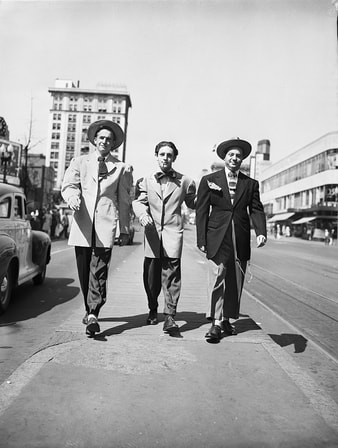 Zoot Suiters in Los Angles in 1943. Photo by Ollie Atkins for the Saturday Evening Post (Public Domain)
Zoot Suiters in Los Angles in 1943. Photo by Ollie Atkins for the Saturday Evening Post (Public Domain) American servicemen and white Angelenos attacked and stripped children, teenagers, and youths who wore zoot suits, ostensibly because they considered the outfits, which were made from large amounts of fabric, to be unpatriotic during World War II. Rationing of fabrics and certain foods was required at the time for the war effort. While most of the violence was directed toward Latinex youth, African American, Italian American, and Filipino American youths who were wearing zoot suits were also attacked.
The Zoot Suit Riots were related to fears and hostilities aroused by the coverage of the Sleepy Lagoon murder trial, following the killing of a young Latinex man in what was then an unincorporated commercial area near Los Angeles. On the night of June 3, 1943, about eleven sailors got off a bus and started walking along Main Street in Downtown Los Angeles. Encountering a group of young Mexicans in zoot suits, they got into an argument. The sailors later told the LAPD that they were jumped and beaten by this gang, while the Zoot suiters claimed the altercation was started by the sailors. The LAPD responded to the incident, including many off-duty officers who identified as the Vengeance Squad. The officers went to the scene "seeking to clean up Main Street from what they viewed as the loathsome influence of pachuco gangs." "Pachocu" referred to all Latinex youth.
The next day, 200 sailors got a convoy of about 20 taxicabs and headed for East Los Angeles, the center of Mexican-American settlement. The sailors spotted a group of young zoot suiters and assaulted them with clubs. They stripped the boys of the zoot suits and burned the tattered clothes in a pile. They attacked and stripped everyone they came across who were wearing zoot suits. Media coverage of the incidents then started to spread, inducing more people to join in the mayhem. The local press lauded the attacks, describing them as having a "cleansing effect" to rid Los Angeles of "miscreants" and "hoodlums".
The Los Angeles City Council approved a resolution criminalizing the wearing of "zoot suits with reat [sic] pleats within the city limits of LA" with the expectation that Mayor Fletcher Bowron would sign it into law. Councilman Norris Nelson had stated, "The zoot suit has become a badge of hoodlumism." No ordinance was approved by the City Council or signed into law by the Mayor, but the council encouraged the WPB to take steps "to curb illegal production of men's clothing in violation of WPB limitation orders.
While the mobs had first targeted only pachucos, they also attacked African Americans in zoot suits who lived in the Central Avenue corridor area. The Navy and Marine Corps command staffs intervened on June 8 to reduce the attacks, confining sailors and Marines to barracks and ordering that Los Angeles be declared off-limits to all military personnel; this was enforced by Navy Shore Patrol personnel. Their official position was that their men were acting in self-defense despite evidence that they were acting in organized groups.
After the Mexican Embassy lodged a formal protest with the State Department, Governor Earl Warren of California ordered the creation of the McGucken Committee (headed by Los Angeles bishop Joseph McGucken) to investigate and determine the cause of the riots. The committee issued its report; it determined racism to be a central cause of the riots, further stating that it was "an aggravating practice (of the media) to link the phrase zoot suit with the report of a crime."
At the same time, Mayor Bowron came to his own conclusion. The riots, he said, were caused by Mexican juvenile delinquents and by white Southerners who had immigrated to Los Angeles. Racial prejudice in Los Angeles, according to Bowron, was not a factor.
On June 16, 1943, a week after the riots, First Lady Eleanor Roosevelt commented on the riots in her newspaper column. "The question goes deeper than just suits. It is a racial protest. I have been worried for a long time about the Mexican racial situation. It is a problem with roots going a long way back, and we do not always face these problems as we should." The Los Angeles Times published an editorial the next day expressing outrage: it accused Mrs. Roosevelt of having communist leanings and stirring "race discord".
On June 21, 1943, the State Un-American Activities Committee, under state senator Jack Tenney, arrived in Los Angeles with orders to "determine whether the present Zoot Suit Riots were sponsored by Nazi agencies attempting to spread disunity between the United States and Latin-American countries." Although Tenney claimed he had evidence the riots were "[A]xis-sponsored", no evidence was ever presented to support this claim.
 RSS Feed
RSS Feed